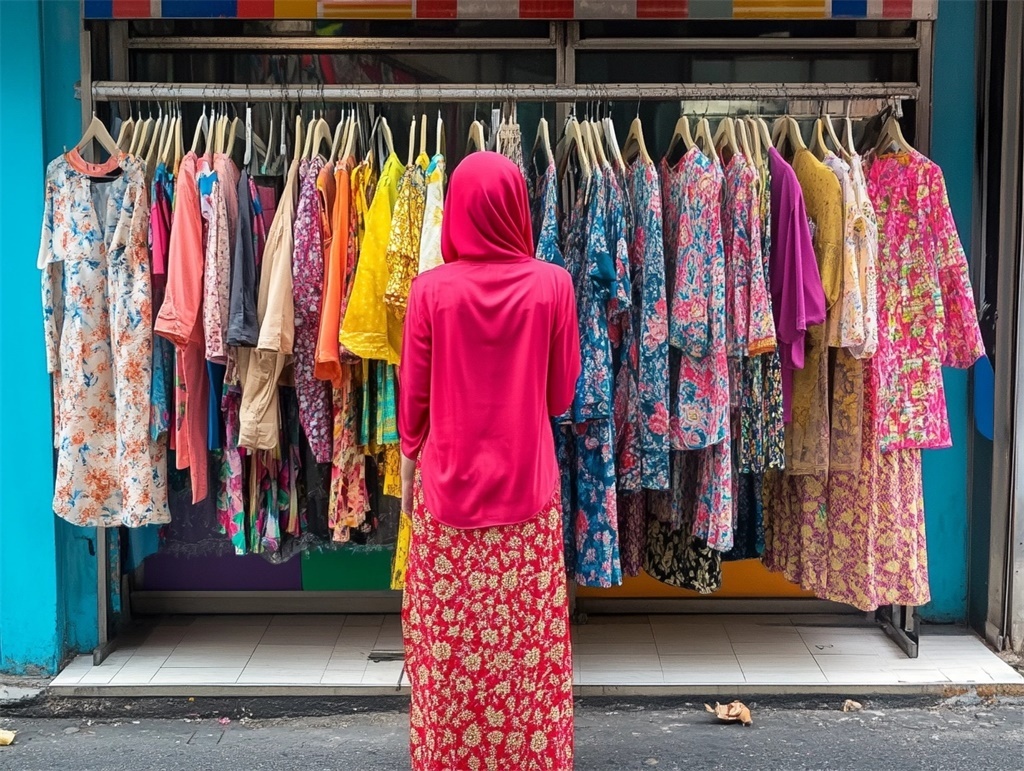引言:
漫步在东南亚的繁华街头,一幅幅色彩斑斓、风情万种的服装画卷徐徐展开。这片热带雨林与珊瑚海交织的土地,孕育出独特而多元的服饰文化。从巴厘岛的传统巴迪克到新加坡的都市潮牌,东南亚的服饰偏好犹如一面镜子,映射出他们对身份认同、信仰习俗及生活态度的深刻理解。然而,在这琳琅满目的时尚风景背后,又隐藏着哪些衣着上的避讳与禁忌?他们的购物车聚焦于哪些售价区间?让我们一同揭开东南亚男性女性服饰世界的神秘面纱。

【传统与现代交织:东南亚服饰风格概览-男性服饰篇】
东南亚男性服饰风格深受地域文化、气候条件以及历史传承的影响。传统服饰如印尼的沙龙(Kebaya)与纱笼(Sarong)、泰国的泰丝衬衫(Thai Silk Shirt)与长裤(Chong Kraben),以其独特的民族图案、舒适的材质与宽松剪裁,展现出浓郁的本土风情。而随着全球化浪潮的席卷,现代时尚元素亦深深渗透,休闲T恤、牛仔裤、运动鞋等国际流行单品成为年轻一代的日常选择。这种传统与现代的交融,使得东南亚男性的衣橱呈现出丰富多元的风貌。
【关键词:传统服饰、现代时尚、地域文化、气候条件、历史传承】
主要内容与子标题:
1. 热带风情:色彩与印花的狂欢
东南亚男性对鲜艳色彩与繁复印花有着天然的喜爱,这不仅源于热带气候对明亮色调的呼唤,更与当地崇尚自然、热爱生活的文化精神紧密相连。从亮丽的橙黄、翠绿到深邃的宝石蓝,各类高饱和度色彩被大胆运用在衬衫、短裤、配饰上,营造出热烈奔放的视觉效果。而富有象征意义的花卉、动物、几何图案印花,则赋予衣物深厚的文化内涵,彰显穿着者的个性与品味。
2. 宗教影响:服饰中的神圣符号
东南亚多宗教共存,佛教、伊斯兰教、印度教等对当地男性服饰产生深远影响。例如,穆斯林男性常穿戴头巾(Songkok)、长袍(Baju Melayu)以示虔诚;佛教徒则倾向于穿着素雅、简洁的服装,避免过于花哨的装饰。此外,某些特定图案或颜色可能被视为神圣不可亵渎,需谨慎搭配。
3. 场合切换:商务与休闲的灵活穿搭
东南亚男性善于根据不同场合调整着装风格。商务场合,他们倾向于选择深色西装搭配领带,展现专业严谨的形象;而在休闲时刻,轻松的短袖衬衫、棉麻长裤与凉鞋组合则更为常见。部分国家如马来西亚、新加坡,工作日还设有“周五便服日”,鼓励员工展现个性化的休闲装扮。
4. 配饰魅力:点亮整体造型的关键
配饰在东南亚男性的服饰搭配中扮演重要角色。从象征身份地位的金项链、手镯,到具有民族特色的编织腰带、草帽,再到实用与美观兼具的竹编包、木质手环,这些小物件为整体造型增添亮点,凸显个人风格。值得注意的是,某些配饰如佛珠、祈祷珠等,可能带有宗教寓意,需了解其背景后再行佩戴。
5. 消费观:性价比为王,品质与设计并重
东南亚男性在购买服饰时,普遍注重性价比。他们倾向于在中低价位(约人民币200-800元)范围内寻找设计新颖、品质优良的产品。本土品牌与快时尚品牌因价格亲民、款式多样而受到青睐,同时,随着网购平台的发展,越来越多消费者开始关注线上折扣与促销活动,以实现更高性价比的购物体验。
【传统与现代交织:东南亚服饰风格概览-女性服饰篇】
东南亚女性的服饰偏好
东南亚女性的服饰选择深受地域文化、气候条件及生活方式影响,形成了独特且鲜明的审美取向。以下五点概括其主要偏好:
1. 色彩斑斓:热带风情浓郁的东南亚,女性偏爱明亮鲜艳的色彩,如艳丽的红、绿、蓝、黄等,以呼应阳光明媚的自然环境,展现活力与乐观态度。
2. 民族元素:传统纹饰、刺绣、印花等民族元素在服饰设计中广泛应用,既彰显本土文化自豪感,又赋予服装独特的艺术韵味。
3. 舒适透气:鉴于湿热气候,东南亚女性倾向于选择轻薄透气的面料,如棉麻、丝质、薄纱等,确保穿着凉爽舒适。
4. 层次搭配:受多元文化影响,东南亚女性善于运用多层次穿搭技巧,如长裙配短外套、围巾披肩等,既防晒又增加时尚感。
5. 混搭风格:现代与传统、东方与西方元素的巧妙融合,使得混搭风格在东南亚女性中大受欢迎,展现出她们开放包容的时尚态度。
东南亚女性衣着避讳与禁忌
1. 宗教尊重:在信仰佛教、伊斯兰教等宗教的地区,需避免穿着过于暴露或与宗教礼仪不符的服饰,如短裙、低胸上衣等。
2. 场合适宜:在正式场合或传统节日中,应遵循特定的着装规范,如印尼的巴迪克长裙、泰国的沙龙等。
3. 图案寓意:部分图案或符号可能具有特定含义,如在某些地区,大象图案象征吉祥,骷髅图案则被视为不吉利,需了解并尊重这些文化符号。
4. 材质禁忌:部分地区可能存在对某种材质的忌讳,如在一些穆斯林社区,可能避免使用含猪皮或猪鬃的纺织品。
5. 年龄与身份相符:服饰选择应符合个人年龄与社会角色,避免过于稚嫩或过于成熟的装扮与身份不符。
东南亚女性的常见款式解析
1. 传统服饰:如越南的奥黛、泰国的沙龙、马来西亚的卡巴雅等,既是民族文化的象征,也是日常及正式场合的常见选择。
2. 休闲便装:包括宽松T恤、阔腿裤、连衣裙等,注重舒适度与时尚感的平衡,适合日常休闲与办公场合。
3. 职场套装:简洁干练的职业装,如西装、衬衫、直筒裙等,满足现代职业女性的需求。
4. 度假风服饰:如波西米亚长裙、吊带裙、沙滩罩衫等,适应东南亚度假胜地的氛围,展现轻松浪漫的夏日风情。
5. 运动休闲装:随着健康生活方式的普及,运动服、瑜伽裤等休闲运动装备也逐渐受到东南亚女性青睐。
另外,东南亚气候湿热,无论是男装还是女装,在面料上面都会偏向选择吸湿排汗、透气性好的天然纤维,如棉、麻、丝等,在售价上面,因地置疑,但是一般情况下,都偏只低等价位,POD服装行业的小伙伴们,可以在主营东南亚市场的shopee、Lazada等跨境电商平台上查看具体的内容,综合该平台的各项费用,物流,佣金,其他杂费等,结合自己的实际情况,看是否可以介入东南亚的市场。
【东南亚时尚潮流趋势前瞻】
随着时尚产业的快速发展与全球视野的拓宽,东南亚男性女性服饰市场正呈现出新的潮流趋势。环保材料的应用、跨文化融合设计、个性化定制服务以及科技智能元素的融入,将引领未来男性女性着装风尚,为消费者提供更多元、更具创新力的选择。
结论:
东南亚男性女性的服饰偏好,犹如一部生动的地域文化史,融汇了传统、现代、宗教、气候等多元因素。她们在遵守衣着避讳与禁忌的同时,展现出对色彩、印花、配饰的独特追求,以及对性价比的敏锐洞察。随着时尚潮流的演变,这一群体将继续以其鲜明的个性与开放的心态,塑造并丰富东南亚乃至全球的男性时尚版图。我们POD服装卖家在了解了这些内容之后,就可以根据自己的判断,看否有机会介入东南亚的跨境电商市场,注意,东南亚很大,不同的国度也有不同的差异,小伙伴们一定要注意甄别和更深入细致的研究,才能找到最适合自己的市场范围和目标群体。
FAQs:
1. 东南亚男性女性最常穿的服装类型是什么?
东南亚男性常穿的服装类型包括传统民族服饰(如沙龙、纱笼、泰丝衬衫等)、休闲T恤、牛仔裤、运动鞋等现代单品,以及符合特定宗教要求的服饰(如穆斯林头巾、长袍等),女性则更加丰富一些,除了传统的服饰外,宽松T恤、阔腿裤、连衣裙以及运动服、瑜伽裤等都有涉及。
2. 东南亚男性女性在衣着上有哪些避讳或禁忌?
避讳与禁忌主要与宗教信仰、文化习俗有关,如穆斯林男性和女性需遮盖头部与身体,避免穿着过于暴露或紧身的衣物;佛教徒则倾向于穿着素雅、简洁的服装,避免过于花哨的装饰。此外,某些特定图案或颜色可能被视为神圣不可亵渎,需谨慎搭配。
3. 东南亚男性女性服饰的主要售价范围是多少?
东南亚男性和女性服饰的主要售价范围通常在人民币200-800元之间,她们倾向于在这个价位内寻找设计新颖、品质优良的产品。
4. 东南亚男性女性如何根据场合调整着装风格?
在商务场合,东南亚男性常选择深色西装搭配领带,展现专业严谨的形象;女性则是职业装,套裙,衬衫之类的选择,而在休闲时刻,他们更喜欢轻松的短袖衬衫、棉麻长裤与凉鞋组合,而女性则更加多种变幻,主要以连衣裙,宽松休闲上衣为主,风格相比男性更加多样化。部分国家设有“周五便服日”,鼓励员工展现个性化的休闲装扮。
5. 东南亚男性女性服饰搭配中,配饰起到什么作用?
配饰在东南亚男性女性的服饰搭配中起到点亮整体造型的关键作用。它们不仅能凸显个人风格,还可能带有宗教、民族等特殊寓意,如金项链、手镯、编织腰带、草帽、竹编包、木质手环等。

